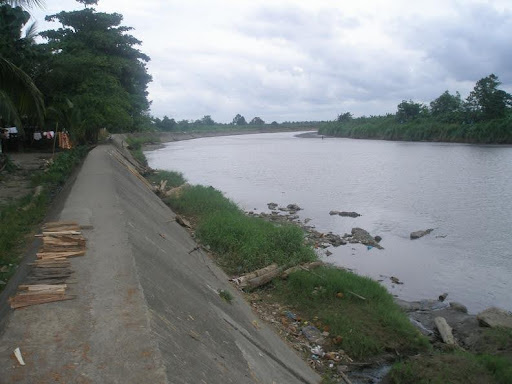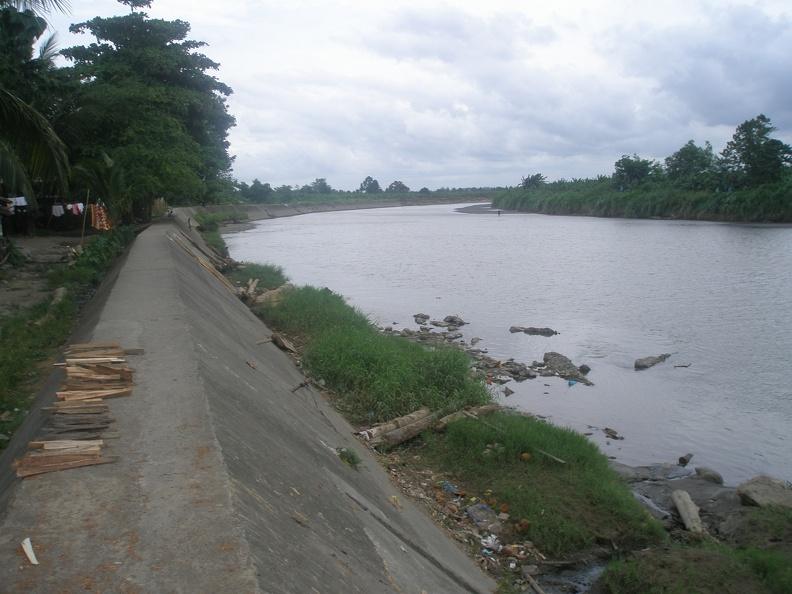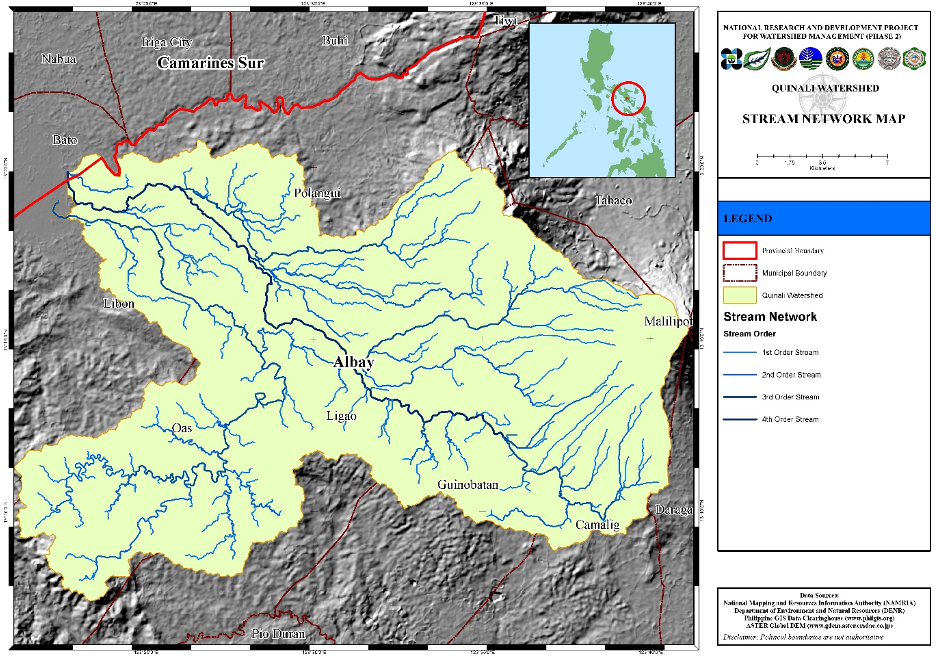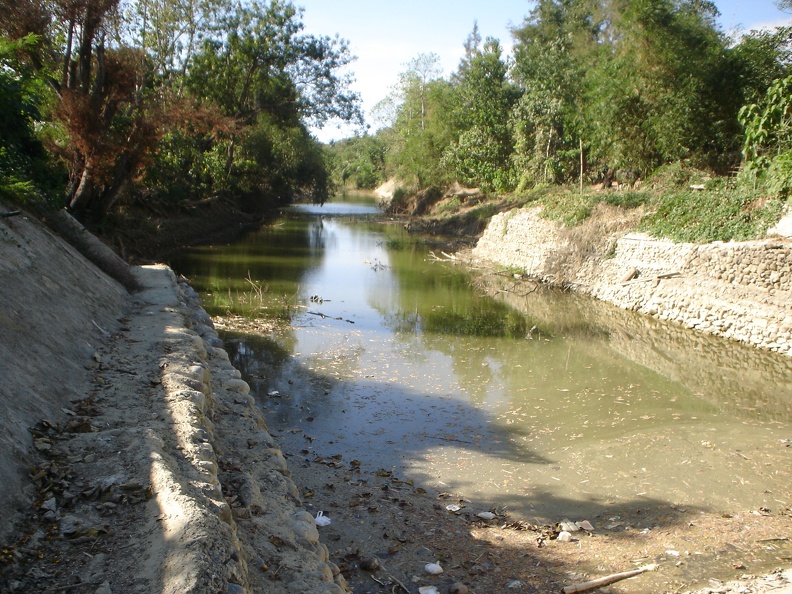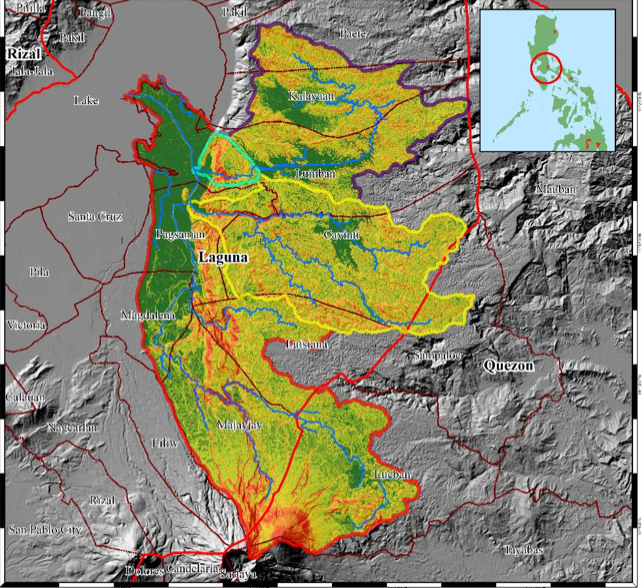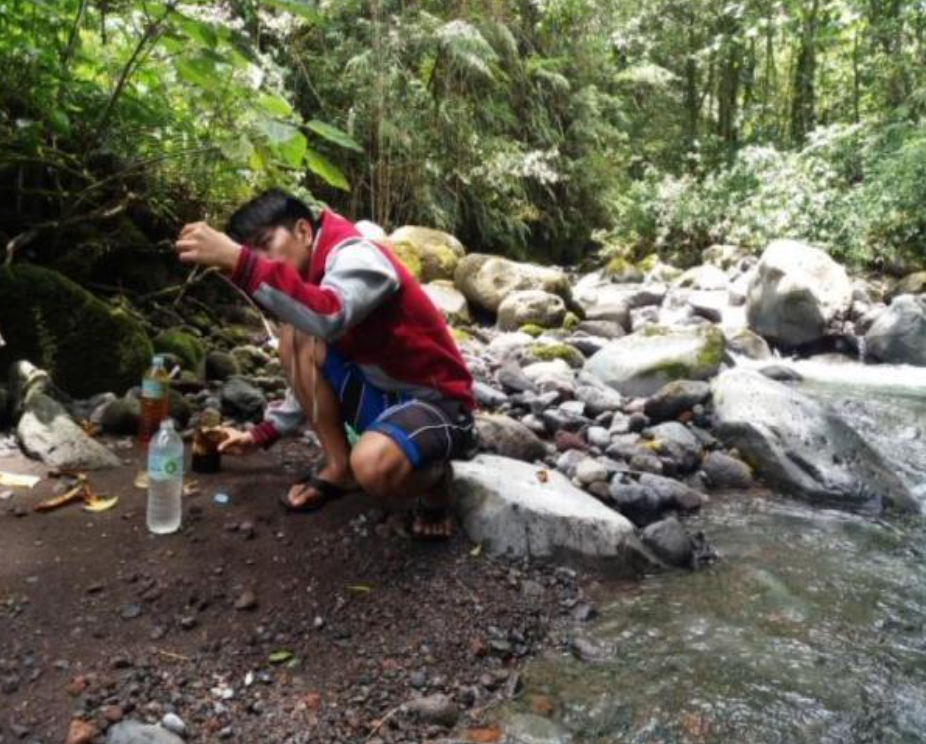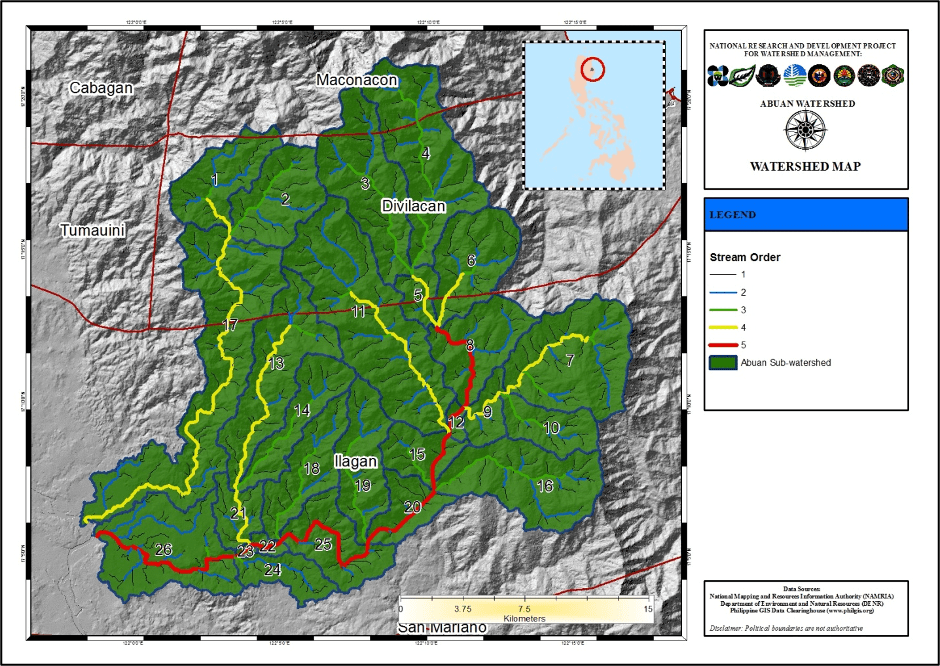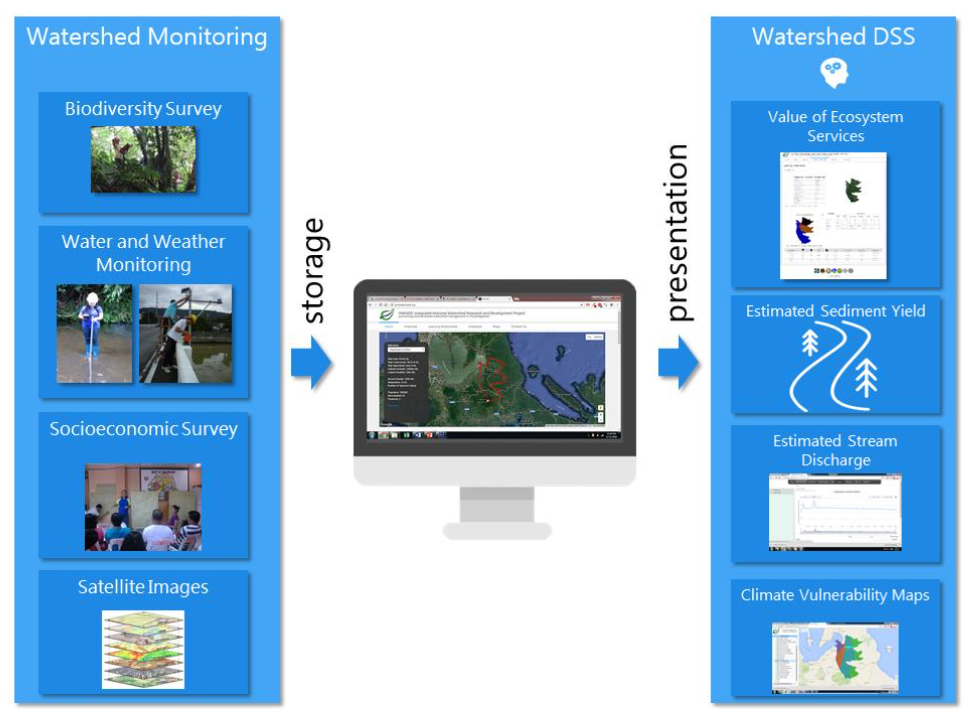Watershed
Industry Strategic Science and Technology Program
Overview
Watershed is an area of land that drains all the streams and rainfall to a common outlet such as the outflow of a reservoir, mouth of a bay, or any point along a stream channel. Healthy and sustainably managed watersheds provide environmental services and economically viable natural resources (i.e. wood/non-wood products) and serve as water sources for domestic, agricultural and industrial uses. They could also serve as habitats to various plant and animal species and play ecological functions. Watersheds also prevent or reduce costly climate change and flooding impacts, manage drought, contribute to tourism and fisheries, forestry, agriculture and mining industries.
Some of the watersheds in the Philippines are the Abuan Watershed in Isabela, Muleta Watershed in Bukidnon, Pagsanjan-Lumban Watershed in Laguna, Quiaoit River Watershed in Ilocos Norte, and Quinali Watershed in Bicol.
Challenges
The Philippines lacks data on watershed characteristics and appropriate monitoring instruments that will aid in making informed planning and decision making with regard to the management and conservation of watershed resources. Other problems faced in the industry are dispersed advocacy efforts and improper planning to adopt integrated watershed-based approaches, and inadequate instrumentation that leads to increased rate of erosion.
Watershed Policies
| Policy Type | Policy Number | Policy Year | Congress | Policy Title | Policy Description | Policy Objective | Policy Link | Commodity | Classification | info_encoder_stamp | info_date_stamp | info_quashing_remarks | filepath |
|---|---|---|---|---|---|---|---|---|---|---|---|---|---|
| Bill | House Bill No. 0266 | 2019 | 18th | An Act Establishing Watershed Reservations In Certain Parcels Of Land Situated In Abra De Ilog, Calintaan, Magsaysay, Mamburao, Paluan, Rizal, Sablayan, Sta. Cruz And San Jose In The Province Of Occidental Mindoro, And Bulalacao, Mansalay, Puerto Galera, And San Teodoro In Oriental Mindoro, And For Other Purposes | Section 1. Title. - This Act shall be known as the "Mindoro Watershed Reservations Act." Section 2. Land classification - All lands comprising the Watersged reservation (identified under this bill) shall fall under the classificatioin of watershed reservation as provided for in the Philippine Constitution. Sectioni 3. Scope and Coverage. The following watersheds are hereby declared as watershed reservation covering parcels of land situated in the provinces of Occidental and Oriental Mindoro | This bill seeks to declare the Amnay Watershed, Busuanga Watershed, Caguray Watershed, Calawagan Watershed, Lumintao Watershed, Mamburao Watershed, Mongpong Watershed, Pagbahan Watershed, and Patrick Watershed located in the Provinces of Occidental and some portions in Oriental Mindoro as Watershed reservations. | https://congress.gov.ph/legisdocs/basic_18/HB00266.pdf | Watershed | Null | Jeff | 11/22/2024 | C:\Users\trist\Documents\Formatting\Output\Watershed_2024-11-22_processed.xlsx | |
| Bill | House Bill No. 462 | 2019 | 18th | An Act Declaring The Tugbo Watershed Forest Reserve (TWFR) Situated In The City Of Masbate, Island Of Luzon As Protected Area Pusuant To Republic Act 7586, Otherwise Known As The National Integrated Protected Areas System (NIPAS) Act Of 1992 And Shall Be Known As Tugbo Natural Biotic Area (TNBA), Appropriating Funds Therefor, And For Other Purposes | Section 1. Title. - This Act shall be known as the "Tugbo Natural Biotic Area (TNBA) Act of 2018" Section 2. State Policy. - It is hereby declared the policy of the State to promote the protection and maintenance of natural and physical diversities of the environment notably of areas of unique biological significance in order to sustain life. Towards this end, it is hereby declared the policy of the State to secure for the Filipino people of present and future surrounding areas in accordance with Republic Act 7586 or the National Integrated Protected Areas System (NIPAS) Act of 1992 and the international conventions to which the Philippines is a signatory. Section 3. Declaration of Policy - Pursuant to the declared policy of the State, the Tugbo Watershed Forest Reserve (TWFR) situated in the City of Masbate and in the municipality of Mobo, province of Masbate is hereby declared and established as Protected Area under the category of a Natural Biotic Area. | The bill seeks to declare the Tugbo Watershed Forest Reserve situated in the city of Masbate and in the municipality of Mobo, province of Masbate, as a protected area pursuant to Republic Act 7586 also known as the NIPAS | https://congress.gov.ph/legisdocs/basic_18/HB00462.pdf | Watershed | Null | Jeff | 11/22/2024 | C:\Users\trist\Documents\Formatting\Output\Watershed_2024-11-22_processed.xlsx | |
| Bill | House Bill No. 1303 | 2019 | 18th | An Act For The Protection, Conservation And Rehabilitation Of Watersheds Supporting The National Irrigation System (NIS) To Ensure Continuous Supply Of Water For Agricultural Production And Self-Sufficiency In Food And Providing Funds For The Purpose | Section 1. Title - The Act shall be known as the "Protecttion of Watersheds Suppoting the National Irrigation System Act of 2016" Section 2. Declaration of Policy - In line with the concept of National Patrimony as embodied in Article XII Section 1 and 2 that all natural resources are owned by the State and its peoples and in consonance with Section 4 of the Constitution that provides that Congress shall, as soon as possible, determine by law the specific limits of forest lands and national parks, making clearly their boundaries on the ground. Thereafter, such forest lands and national parks shall be conserved and may not be increased nor diminished, except by law. | The bill seeks to ensure the protection, conservation and rehabilitation of the watersheds supporting the National Irrigation System | https://congress.gov.ph/legisdocs/basic_18/HB01303.pdf | Watershed | Null | Jeff | 11/22/2024 | C:\Users\trist\Documents\Formatting\Output\Watershed_2024-11-22_processed.xlsx | |
| Bill | House Bill No. 2790 | 2019 | 18th | An Act Declaring Certain Portions Of Cagayan De Oro City To Be Known As The Cagayan De Oro-Iponan Watershed As A Protected Area Under The Category Of Protected Landscape And Its Peripheral Areas As Buffer Zone, Providing For Its Management And For Other Purposes | Section 1. Title - This Act shall be known and cited as "Cagayan de Oro-Iponan Protected Landscape Act" Section 2. Declaration of Policy - It is the policy of the State to protect and advance the right of people to a balanced and healthful ecology in accord with the rhythm and harmony of nature. For this purpose, the State shall secure for the present and future generations of Filipinos the perpetual existence of all flora and fauna within Cagayan de Oro-Iponan Watershed in the City of Cagayan de Oro through its establishment as a component of the National Integrated Protected Areas System (NIPAS) under the category of protected landscape, without prejudice to the continued occupation threat of the Higaonan Tribe whose cultural and historical affinity with the area have long been established by formal and anecdotal evidence. The State shall likewise promote the participation of local communities in the management of the Cagayan de Oro-Iponan Protected Landscape and protect the way of life of the people living in and around the protected area. | The bill seeks to effectively manage the watershed in Cagayan de Oro City | https://congress.gov.ph/legisdocs/basic_18/HB02790.pdf | Watershed | Null | Jeff | 11/22/2024 | C:\Users\trist\Documents\Formatting\Output\Watershed_2024-11-22_processed.xlsx | |
| Bill | House Bill No. 5189 | 2019 | 18th | An Act Declaring The Northern Zambales Watersheds And Subwatersheds Located In The Municipalities Of Masinloc, Candelaria And Sta. Cruz In The Province Of Zambales As Protected Areas Under The Category Of Protected Landscapes To Be Known As The Northern Zambales Protected Landscape, Providing For Its Management And For Other Purposes | Section 1. This Act shall be known and cited as "The Northern Zambales Protected Landscape Act." Section 2. Declaration of Policy - It is the policy of the State to protect and advance the right of people to a balanced and healthful ecology in accord with the rhythm and harmony of nature. For this purpose, the State shall secure for the present and future generations of Filipinos the perpetual existence of all flora and fauna within the Northern Zambales Watersheds and Suwatersheds in the municipalities of Masinloc, Candelaria and Sta. Cruz, province of Zambales, through its establishment as a component of the National Integrated Protected Areas System (NIPAS) under the category of protected landscape. The State shall likewise promote the participation of local communities in the management of the Northern Zambales Watersheds and Suwatershed and protect the way of life of the people living in and around the protected area. | The bill seeks to create the Northern Zambales Protected Landscape within the Northern Zambales Watersheds and Sub-watershed in the municipalities of Masinloc, Candelaria and Sta. Cruz, province of Zambales, through its establishment as a component of the National Integrated Protected Areas System (NIPAS) under the category of protected landscape. The total area of the protected areas is Eighty-Four Thousand Four Hundred Eighty-Six (84,486.00 has.), more or less. | https://congress.gov.ph/legisdocs/basic_18/HB05189.pdf | Watershed | Null | Jeff | 11/22/2024 | C:\Users\trist\Documents\Formatting\Output\Watershed_2024-11-22_processed.xlsx | |
| Bill | House Bill No. 7188 | 2020 | 18th | An Act Declaring The Zambales Watersheds And Subwatersheds Located In The Municipalities Of Botolan, Iba, Palauig, Masinloc, Candelaria, And Sta. Cruz In The Province Of Zambales As Protected Areas Under The Category Of Protected Landscapes To Be Known As The Zambales Protected Landscapes, Providing For Its Management And For Other Purposes | Section 1. This Act shall be known and cited as "The Zambales Protected Landscape Act." Section 2. Declaration of Policy - It is the policy of the State to protect and advance the right of the people to a balanced and healthful ecology in accord with the rhythm and harmony of nature. For this purpose, the State shall secure for the present and future generations of Filipinos the perpetual existence of all native plants and animals within the Watersheds and Subwatersheds in the proince of Zambales which are located in municipalities of Botolan, Iba, Palauig, Masinloc, Candelaria, and Sta. Cruz, through its establishment as a component of the National Integrated Protected Areas System (NIPAS) under the category of protected landscape. The State shall likewise promote the participation of local communities in the management of the Zambales Watersheds and Subwatershed and protect the way of life of the people living in and around the protected area. | The bill proposes the creation of the Zambales Protected Landscapes within the Zambales Watersheds and Sub-watershed in the municipalities of Botolan, Iba, Palauig, Masinloc, Candelaria and Sta. Cruz, province of Zambales through its establishment as a component of the National Integrated Protected Areas System (NIPAS) under the category of protected landscape. The total area of the protected area is One Hundred Fifty-Eight Thousand Seven Hundred Ninety Five (158,795.00 has.) more or less. | https://congress.gov.ph/legisdocs/basic_18/HB07188.pdf | Watershed | Null | Jeff | 11/22/2024 | C:\Users\trist\Documents\Formatting\Output\Watershed_2024-11-22_processed.xlsx | |
| Bill | House Bill No. 7501 | 2020 | 18th | An Act Declaring The Pantaron Mountain Range As A Protected Area Categorized As A National Park And Watershed, And Providing For Its Management And Administration | Section 1. Title - This Act shall be known as and cited as "Pantaron Mountain Range National Park Act" Sec. 2. Land Categorization Under the 1987 Constitution - All lands comprising the Pantaron Mountain Range shall fall under the category of National Park and Watershed Reservation under Article 12 Section 4 of the 1987 Constitution, to be known as the Pantaron Range National Park and Watershed. | The bill seeks for the entire area encompassing Pantaron Mountain Range to be protected from threats of abuse and destruction and at the same time provide for sustainable development in the area for generations to come. | https://congress.gov.ph/legisdocs/basic_18/HB07501.pdf | Watershed | Null | Jeff | 11/22/2024 | C:\Users\trist\Documents\Formatting\Output\Watershed_2024-11-22_processed.xlsx | |
| Bill | House Bill No. 8184 | 2020 | 18th | An Act Amending Certain Portions Of Republic Act No. 7492, Otherwise Known As The "Philippine Mining Act Of 1995" By Prohibiting Mining In Watersheds, Requiring A Legislative Franchise For Mining Operations, And For Other Purposes | Amendments to the following sections of the Philippine Mining Act of 1995: Section 5 Section 19 Section 27 Section 30 Section 31 Section 32 Section 33 Section 39 Section 41 Section 55 Section 70-A Section 70-B Section 103 Repealing of the following sections: Section 53 Section 58 | The bill seeks to achieve the following objectives: 1. Include watersheds, in general, as well as critical watersheds, as part of the enumerated areas closed to mining applications. 2. Requires the acquisition of a legislative franchise from Congress for mining operations in the Philippines. 3. Clarify that the contents of permits and agreements should be considered as public information, further confidentiality clauses which shroud secrecy the contents of the permits and agreements are null and void 4. Provide mandatory domestic processing of all mineral ores in the Philippines and banning of the exportation of unprocessed mineral ores, as determined by the Department of Environment and Natural Resources (DENR) | https://congress.gov.ph/legisdocs/basic_18/HB08184.pdf | Watershed | Null | Jeff | 11/22/2024 | C:\Users\trist\Documents\Formatting\Output\Watershed_2024-11-22_processed.xlsx | |
| Bill | House Bill No. 8430 | 2021 | 18th | An Act Declaring Lumbo Spring Located In The Municipality Of Dolores, Quezon Province As A Protected Watershed Reserve And For Other Purposes | Section 1. Title. - This Act shall be known as the "Lumbo Spring Watershed Reserver Act" Section 2. Land Classification. - All lands comprising the Watershed Reserve (identified under this bill) shall fall under the classification of WATERSHED Reserve as provided for in the 1987 Constitution and other laws | The bill seeks to declare the Lumbo Spring as a protected Watershed Reserve located at the municipality of Dolores, Quezon Province | https://congress.gov.ph/legisdocs/basic_18/HB08430.pdf | Watershed | Null | Jeff | 11/22/2024 | C:\Users\trist\Documents\Formatting\Output\Watershed_2024-11-22_processed.xlsx | |
| Resolution | House Resolution No. 549 | 2019 | 18th | Resolution To Utilize Idle Lands In Military Reservations And In State Universities And Colleges (SUCs), On Ancestral Lands, And On Watersheds And Land Areas Within The Laguna Lake Development Authority'S (LLDA's) Jurisdiction For The Establishment Of Commercial Bamboo Plantations Using Commercial Bamboo Species | Executive Order or EO 879 established the Philippine Bamboo Industry Development Council (PBIDC) to provide the over-all policy and directions of the bamboo industry programs for all stakeholders; One way to provide the bamboo industry its needed raw material supply is for the private sector to establish commercial bamboo plantations of commercial species The establishment of commercial bamboo plantations in the idle lands of the military reservations and SUCs; ancestral lands; and watersheds and land areas within the LLDS's jurisdiction are part of the ENGP | To utilize idle lands in military reservations and in state universities and colleges (SUCs), on ancestral lands, and on watersheds and land areas within the laguna lake development authority's (LLDA's) jurisdiction for the establishment of commercial bamboo plantations using commercial bamboo species | https://congress.gov.ph/legisdocs/basic_18/HR00549.pdf | Watershed | Null | Jeff | 11/22/2024 | C:\Users\trist\Documents\Formatting\Output\Watershed_2024-11-22_processed.xlsx | |
| Resolution | House Resolution No. 1345 | 2020 | 18th | A Resolution Directing The Appropriate Committee Of The House Of Representatives To Conduct An Investigation, In Aid Of Legislation, On The Untimely And Irresponsible Opening Of Floodgates Of Dams And Watersheds In Luzon During The Onslaught Of Typhoon Ulysses | There is a need to conduct an investigation to determine the accountability of dam operators in the casualties that took the lives and livelihood of many Filipinos | To direct the appropriate committee of the House of Representatives to conduct an investigation, in aid of legislation, on the untimely and irresponsible opening of floodgates of dams and watersheds in Luzon during the onslaught of Typhoon Ulysses | https://congress.gov.ph/legisdocs/basic_18/HR01345.pdf | Watershed | Null | Jeff | 11/22/2024 | C:\Users\trist\Documents\Formatting\Output\Watershed_2024-11-22_processed.xlsx | |
| Resolution | House Resolution No. 1346 | 2020 | 18th | A Resolution Directing The Appropriate Committee Of The House Of Representatives To Conduct An Investigation, In Aid Of Legislation, Of The Continuous And Long-Standing Illegal Activities Such As Logging And Quarrying In The Marikina Watershed And Other Protected Reserves | The rehabilitation of the Marikina watershed is of utmost importance as it servs as the first line of defense against wainwater coming from the uplands of Luzon. It also serves as home to various endangered wildlife species like Narra, red and white Lauan, Kamagong, Molave; Fauna birds like black-naped Oriole and jungle fowl; mammals like Philippine Deer, wild pig, Philippine monkey, among many others; | To direct the appropriate committee of the House of Representatives to conduct an investigation, in aid of legislation, of the continuous and long-standing illegal activities such as logging and quarrying in the Marikina Watershed and other protected reserves | https://congress.gov.ph/legisdocs/basic_18/HR01346.pdf | Watershed | Null | Jeff | 11/22/2024 | C:\Users\trist\Documents\Formatting\Output\Watershed_2024-11-22_processed.xlsx | |
| Resolution | House Resoultion No. 1361 | 2020 | 18th | A Resolution Directing The Special Committee On Reforestation To Conduct An Inquiry, In Aid Of Legislation, Into The Status Of The Government’S National Greening Program (NGP) And Other Programs Intended To Protect Forest Resources And Watersheds | The National Greening Program and other programs intended to protect forest resources and watersheds must uphold not only the country's commitment to combating the adverse efefcts of the climate reduction plans, and must greatly explore its potential for the production of jobs for Filipinos and the preservation of our biodiversity | That the Special Committee on reforestation be directed to conduct an inquiry, in aid of legislation, into the status of the Government's National Greening Program (NGP) and other programs intended to protect forest resources and watershed | https://congress.gov.ph/legisdocs/basic_18/HR01361.pdf | Watershed | Null | Jeff | 11/22/2024 | C:\Users\trist\Documents\Formatting\Output\Watershed_2024-11-22_processed.xlsx | |
| Bill | House Bill No. 124 | 2016 | 17th | An Act Declaring The Pasonanca Watershed Forest Reserve Located In Zamboanga City As A Protected Area Under The Category Of Natural Park And Providing For Its Management | Section 1. Title - This Act shall be known as the "Pasonanca Natural Park Act" Section 2. Declaration of Policy - Considering the importance of the Pasonanca Watershed Forest Reserve's unique biological resources and its aesthetic, the State to further secure its protection and conservation, including the people and the communities residing therein as well as their way of life. For this reason, the State shall protect and conserve its biodiversity; advance, respect and protect the customs and interests of its legitimate inhibitants; and foster partnerships among government, nongovernment organizations (NGOs) and people's organizations (POs). | The bill seeks to establish the Pasonanca Watershed Forest Reserve in Zamboanga City as a Protected Area under the category of a natural park, to be known as the Pasonanca Natural Park | https://congress.gov.ph/legisdocs/basic_17/HB00124.pdf | Watershed | Null | Jeff | 11/22/2024 | C:\Users\trist\Documents\Formatting\Output\Watershed_2024-11-22_processed.xlsx | |
| Bill | House Bill No. 2116 | 2016 | 17th | An Act Declaring The Tinuy-An Falls And Its Watershed Areas Located In The City Of Bislig, Province Of Surigao Del Sur As A Protected Area Under The Category Of Protected Landscape | Section 1. Tinuy-an Falls as a Natural Park - The Tinuy-an Falls in the City of Bislig, province of Surigao del Sur is hereby declared as a protected area under the category of a protected landscape Section 2. Land Classification - All lands covering the Tinuy-an Falls and its watershed areas shall fall under the classification of national park | The bill seeks to declare the Tinuy-an Falls and its surrounding watershed areas as a pritected area under the category of protected landscape | https://congress.gov.ph/legisdocs/basic_17/HB02116.pdf | Watershed | Null | Jeff | 11/22/2024 | C:\Users\trist\Documents\Formatting\Output\Watershed_2024-11-22_processed.xlsx | |
| Bill | House Bill No. 2685 | 2016 | 17th | An Act Declaring The Mount Diwata Watershed Forest Reserve And Its Surrounding Areas Situated In The Municipality Of San Fernando, Ticao Island, Province Of Masbate As Natural Biotic Area, Pursuant To Republic Act 7586, Otherwise Known As The National Integrated Protected Areas System (NIPAS) Act Of 1992 | Section 1. Title - This Act shall be known as the Mount Diwata Natural Biotic Area (MDNBA) Act of 2016 Section 3. Declaration of Policy - Pursuant to the above policy, the NIPAS Act and as provided herein, Mount Diwata Watershed Forest Reserve (MDWFR) and its surrounding viscinities with boundaries as described hereunder, is hereby declared and established as a protected area under the category of a Natural Biotic Area to be known as the Mount Diwata Natural Biotic Area (TNBA) | The bill proposes for the declaration of Mount Diwata Watershed Forest Reserve (MDWFR) and its surrounding areas as a Natural Biotic Area and providng funds for the purpose | https://congress.gov.ph/legisdocs/basic_17/HB02685.pdf | Watershed | Null | Jeff | 11/22/2024 | C:\Users\trist\Documents\Formatting\Output\Watershed_2024-11-22_processed.xlsx | |
| Bill | House Bill No. 3147 | 2016 | 17th | An Act Creating The Lake Lanao Watershed Development Authority And Providing Funds Therefor | Section 1. Title - This Act shall be known as the "Lanao Lake Watershed Development Authority Act of 2016." Section 2. Declaration of Policy - It is hereby declared to be the national policy to pormote and accelarate the development and balanced growth of the Lake Lanao Watershed area consistent with the national and regional plans and policies for social and economic development and to carry out a comprehensive development plan of the Lake Lanao Watershed area, within the contect of adequate provisions for environmental management and control, preservation of the quality of human life, environment and ecological systems | The bill proposes to create a Lake Lanao Development Authority that shall make and implement a comprehensive development plan designed to promote the rapid social and economic development of Lake Lanao as well as its protection and conservation. | https://congress.gov.ph/legisdocs/basic_17/HB03147.pdf | Watershed | Null | Jeff | 11/22/2024 | C:\Users\trist\Documents\Formatting\Output\Watershed_2024-11-22_processed.xlsx | |
| Bill | House Bill No. 3870 | 2016 | 17th | An Act Declaring The Taal Volcano Island National Park, Province Of Batangas, Island Of Luzon, And Its Watershed Areas, A Protected Area Under The Category Of Protected Landscape And Providing For Its Management And For Other Purposes As Mandated For By The NIPAS Act Of 1992 | Section 1. Title - This Act shall be known as the "Taal Volcano Protected Landscape Act." Section 2. Declaration of Policy - Pursuant to Republic Act 7586 or the NIPAS Act of 1992, it is hereby declared the policy of the state to regulate the utilization of fishery resources, historical artifacts and sites, ensure the continuity of endangered, threatened and rare species, and providing thereof for the benefit and enjoyment of its people and humankind | The bill seeks to establish the Taal Volcano Protected Landscape (TVPL) under the National Integrated Protected Areas System (NIPAS) | https://congress.gov.ph/legisdocs/basic_17/HB03870.pdf | Watershed | Null | Jeff | 11/22/2024 | C:\Users\trist\Documents\Formatting\Output\Watershed_2024-11-22_processed.xlsx | |
| Bill | House Bill No. 6201 | 2017 | 17th | AN ACT DECLARING THE SAPANGBATO WATERSHED IN ANGELES CITY, PAMPANGA AS A PROTECTED AREA AND ECO-PARK, PRESCRIBING PENALTIES AND APPROPRIATING FUNDS THEREFORE, AND FOR OTHER PURPOSES | Section 1. Title - This Act shall be known as, "Sapangbato Watershed Protection Act of 2017." Section 2. Declaration of Policy - It is hereby declared the policy of the State to provide a sustainable development for local government units which shall ensure the sustainability of water not only to protect our environment but ensure the sustainability of life in the future. Likewise, the State shall provide alternative livelihood to increase household income, and food security, design programs for the improvement of delivery of basic and social services, encourage community participation in the implementation of government services, promote responsible citizenship and unity in every barangay and encourage greater private sector participation in community development | The bill seeks to protect the area of Sapang Bato, and declare it as a watershed sanctuary, prohibit further destruction, irresposible development, and provide appropriate funding to reforestation, maintenance, and its development as it contributes to the water supply of the city. | https://congress.gov.ph/legisdocs/basic_17/HB06201.pdf | Watershed | Null | Jeff | 11/22/2024 | C:\Users\trist\Documents\Formatting\Output\Watershed_2024-11-22_processed.xlsx | |
| Bill | House Bill No. 6884 | 2017 | 17th | AN ACT DECLARING THE MARANDING WATERSHED AREA LOCATED IN THE MUNICIPALITIES OF SALVADOR, SAPAD, NUNUNGAN, TANGKAL, AND KAPATAGAN, PROVINCE OF LANAO DEL NORTE AS COMPONENTS OF THE NATIONAL INTEGRATED PROTECTED AREAS SYSTEM UNDER THE CATEGORY OF PROTECTED LANDSCAPE AND PROVIDING FOR ITS MANAGEMENT | Section 1. Short Title. - This Act shall be cited as the "Maranding Protected Landscape Act." Section 2. Declaration of Policy. - It is the policy of the State to protect and advance the right of the people to a balanced and healthful ecology in accord with the rhythm and harmony of nature. For this purpose, the State shall secure for the present and future generatins of Filipinos the perpetual existence of all native plants and animals within the Maranding Watershed Araea in the municipalities of Salvador, Sapad, Nunungan, Tangkal and Kapatagan, Province of Lanao del Norte through its establishment as a component of the National Integrated Protected Areas System under the category of protected landscape. The State shall likewise promote the participation of local communities in the management of the Maranding Watershed Area and protect the way of life of the people living in and around the protected area. | The bill seeks to declare the Maranding Watershed Area situated in the municipalities of Salvador, Sapad, Nunungan, Tangkal and Kapatagan as components of the National Integrated Protected Areas System under the category of protected landscape. | https://congress.gov.ph/legisdocs/basic_17/HB06884.pdf | Watershed | Null | Jeff | 11/22/2024 | C:\Users\trist\Documents\Formatting\Output\Watershed_2024-11-22_processed.xlsx | |
| Bill | Senate Bill No. 1711 | 2020 | 18th | An Act Declaring The Tugbo Watershed Forest Reserve Located In The City Of Masbate And The Municipality Of Mobo In The Province Of Masbate As A Protected Area Under Republic Act No. 7586, As Amended By Republic Act No. 11038, Otherwise Known As The Expanded National Integrated Protected Areas System Act Of 2018, Providng For Its Management, And For Other Purposes | Section 1. Ttitle - This Act shall be known as the "Tugbo Natural Biotic Area Act of 2020" Section 2. Declaration of Policy - The Tugbo Natural Biotic Area is hereby declared to be included in the list No. 11038, categorized under ENIPAS as natural biotic aea, defined under Section 4(w) of the same law, as "an area set aside to allow the way of life of societies living in harmony with the environment to adapt to modern technology at their pace." | The bill seeks to declare the Tugbo Watershed Forest Reserve as a protected area, to be known as the Tugbo Natural Biotic Area, under the provisions of the NIPAS Act, as amended | http://legacy.senate.gov.ph/lisdata/3322430065!.pdf | Watershed | Null | Jeff | 11/22/2024 | C:\Users\trist\Documents\Formatting\Output\Watershed_2024-11-22_processed.xlsx | |
| Bill | Senate Bill No. 942 | 2019 | 18th | An Act For The Protection, Conservation And Rehabilitation Of Watersheds Supporting The National Irrigation System (Nis) To Ensure Continuous Supply Of Water For Agricultural Production And Self-Sufficiency In Food And Providing Funds For The Purpose | Section 1. Title - The Act shall be known as the "Protection of Watersheds for Irrigiation Act" Section 2. Declaration of Policy - The State affirms its policy for National Patrimony as embodied in Article XII Section 1 and 2 that all natural resources are owned by the State and its peoples and in consonance with Section 4 of the Constitution that provides that Congress shall, as soon as possible determine by law the specific limites of forest lands and national parks, marking clearly their boundaries on the ground. Thereafter, such forest lands and national parks shall be conserved and may not be increased no diminished, except by law | The bill seeks to ensure the protection, conservation, and rehabilitation of the watersheds supporting the National Irrigation System. It is only thru an enactment of a law that will protect, preserve and rehabilitate these watersheds that we can be assured that these areas cannot be touched by man's insensitivity to nature and his environment. We must remember that the environment is not ours to keep but to safeguard, for it is just borrowed from our children. | http://legacy.senate.gov.ph/lisdata/3133628232!.pdf | Watershed | Null | Jeff | 11/22/2024 | C:\Users\trist\Documents\Formatting\Output\Watershed_2024-11-22_processed.xlsx | |
| Bill | Senate Bill No. 748 | 2016 | 17th | An Act Declaring The Taal Volcano Island National Park, Province Of Batangas, Island Of Luzon, And Its Watershed Areas, A Protected Area Under The Category Of Protected Landscape And Providing For Its Management And For Other Purposes As Mandated For By The Nipas Act Of 1992 | Section 1. Title - This Act shall be known as the "Taal Volcano Protected Landscape Act." Section 2. Declaration of Policy - Pursuant to Republic Act 7586 or the NIPAS Act of 1992, it is hereby declared the policy of the state to regulate the utilization of fishery resources, historical artifacts and sites, ensure the continuity of endangered, threatened and rare species, and providing thereof for the benefit and enjoyment of its people and humankind | The bill seeks to establish the Taal Volcano Protected Landscape (TVPL) under the National Integrated Protected Areas System (NIPAS) | http://legacy.senate.gov.ph/lisdata/2428020881!.pdf | Watershed | Null | Jeff | 11/22/2024 | C:\Users\trist\Documents\Formatting\Output\Watershed_2024-11-22_processed.xlsx | |
| Bill | Senate Bill No. 155 | 2016 | 17th | An Act To Promote The Protection,Conservation And Rehabilitation Of Watersheds Supporting The National Irrigation Systems (Nis) To Guarantee Continuing Supply Of Water For Agricultural Production And To Increase The Productivity Of Farmers To Sustain Food Self-Sufficiency And Providing The Funding Thereof | Section 1. Title - The Act shall be known as the "Protection of Watersheds Supporting the National Irrigation Systems." Section 2. Declaraion of Policy - In line with the concept of the National Patrimony as embodied in | The bill is crafted to ensure the protection, conservation and rehabilitation of the watersheds supporting the national irrigation systems, thru an enactment of a law that will protect, preserve and rehabilitate these watersheds so we can be assured that these areas cannot be touched by man's insensitivity to nature and his environment | http://legacy.senate.gov.ph/lisdata/2357720205!.pdf | Watershed | Null | Jeff | 11/22/2024 | C:\Users\trist\Documents\Formatting\Output\Watershed_2024-11-22_processed.xlsx |
Watershed Science and Technology Program
including stream, climatological, biodiversity and soil erosion and sediment yield.
The target outcomes are:
- Integrated landscape modeling/planning and innovative environmental governance
- Improved planning and reduced rates of soil erosion and water degradation
- Database and information system of all the watersheds
Strategic R&D
Strategic R&D is DOST-PCAARRD’s banner program comprising all R&D activities that are intended to generate outputs geared towards maximum economic and social benefits
This two year research project conducted in Saug Watershed in Davao del Norte and Compostela Valley Province yielded several significant science-based data and results, as...
Based on the results of the study the following conclusions were drawn: The biological characteristics of Saug watershed is already degraded considering the low biodiversity...
The Quinali Watershed’s natural and man-made features, the land cover and corresponding land use, and the climate, particularly precipitation, affect the quality of its water...
This project is a member of the national watershed network with the primary aim of developing a management decision support system for watersheds. It has...
The watershed has a relatively flat to moderately sloping to rolling topography starting from the lakeshore going towards the mountains. In the case of the...
Primary objectives of the project are measured based on the existing data and information generated within the study duration of the program. As part of...
This project report presents the characterization of the Abuan Watershed in the province of Isabela in terms of its social, physical and biodiversity aspect. Various...
Technologies
Products, equipment, and protocols or process innovations developed to improve productivity, efficiency, quality, and profitability in the agriculture and aquatic industries, and to achieve sustainable utilization and management of natural resources
- Published On: March 23, 2022
The Watershed Decision Support System (WDSS) uses modern information and communication technologies to provide support across the three main phases of decision-making: (i) he gathering...
Capacity Building
Capacity building efforts of DOST-PCAARRD seek to develop and enhance the R&D capabilities of researchers and academic or research institutions through graduate assistantships, non-degree trainings & development, and/or upgrading of research facilities.
Infrastructure Development
Manpower Development
Policy Research & Advocacy
Analysis of policy concerns and advocacy of science-informed policies ensures that the AANR policy environment is conducive for S&T development and investments.
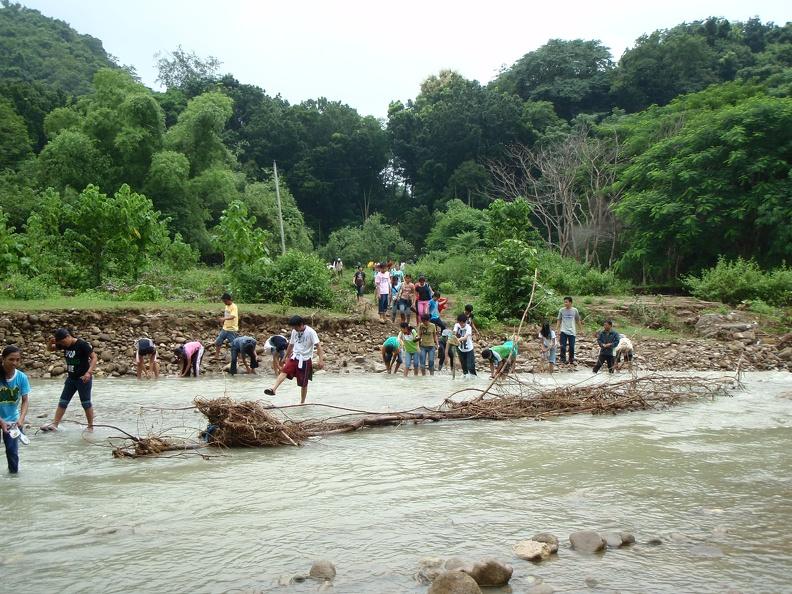
Assessment of Payment for Water Ecosystem Service (P-WES) Initiatives Towards the Development of a Philippine PES Protocol
There are various PES schemes that are documented/reported to be existing in the country, with services including watershed protection, carbon sequestration, water supply, flood mitigation, aesthetic and recreational value, and biodiversity. However, these are short- lived PES-like initiatives. A successful and market-driven PES is yet to be implemented in the country. This project will complement an on-site research on PES that will be conducted in Barobbob Watershed in Nueva Vizcaya to provide a road map that looks back at the success and failures of previous initiatives. In this light, the project will contribute to the establishment of workable arrangements to form a well-informed National PES Policy.
Reference(s):
Institutionalization of Guidelines on Watershed-Based Integrated Area Land Use Planning Towards Resiliency (WILUP)
The main objective of the project is to facilitate the institutionalization of the proposed guidelines on WILUP to promote the resiliency and sustainability of watersheds, ecosystems and people, towards resilient and sustainable local and national development. Specifically, it aims to: 1. Advance the advocacy agenda by building partnerships with DENR, DILG, DHSUD, DA, DAR, DPWH, CCC, NDRRMC, NEDA, and other concerned agencies; 2. Facilitate the adoption of a policy instrument that will initiate the implementation of the WEM framework; 3. Improve appreciation of the WEM framework and WILUP among the key stakeholders; and, 4. Demonstrate/pilot test the WILUP as basis for updating comprehensive land use plans in selected LGUs to showcase its doability and advantages over existing approaches.
Reference(s):
Enhanced capacity and awareness of local communities and other stakeholders in watershed management monitoring
The main objective of the project is to facilitate the institutionalization of the proposed guidelines on WILUP to promote the resiliency and sustainability of watersheds, ecosystems and people, towards resilient and sustainable local and national development. Specifically, it aims to: 1. Advance the advocacy agenda by building partnerships with DENR, DILG, DHSUD, DA, DAR, DPWH, CCC, NDRRMC, NEDA, and other concerned agencies; 2. Facilitate the adoption of a policy instrument that will initiate the implementation of the WEM framework; 3. Improve appreciation of the WEM framework and WILUP among the key stakeholders; and, 4. Demonstrate/pilot test the WILUP as basis for updating comprehensive land use plans in selected LGUs to showcase its doability and advantages over existing approaches.
Reference(s):


